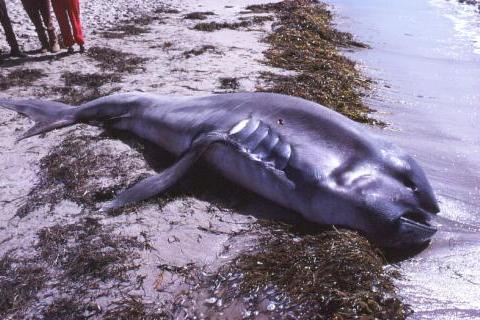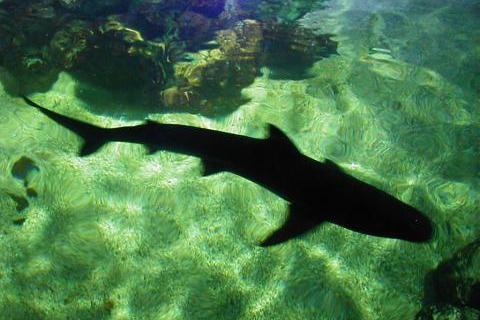Sharks & Rays
When people think of sharks they tend to think of the big ones, such as the great white or tiger shark, and are often surprised to learn that we have several species off the coast of the UK, including large, fast, predatory species such as the porbeagle and mako and the giant plankton-eating basking shark. Excluding the controversial great white, there are 35 species of shark and 26 species of skate/ray found in British waters.
Species
Questions
Are sharks primitive?
Sharks are an ancient group of animals, but despite retaining many early characteristics are far from primitive.
Do sharks have any predators/threats?
Sharks are eaten by a variety of species, from gulls to whales. Humans are by far their biggest predator, however.
Have scientists have changed the name of the Lesser-spotted dogfish to Small-spotted catshark?
Small-spotted catsharks have been incorrectly referred to as "dogfish" for decades. Recently there has been a drive by marine biologists to set the record straight.
How can marine mammals see underwater but we can’t?
Marine mammals and fish have several adaptations to the shape, density and muscle configuration of their eyes that affects how light behaves upon entry.
How do elasmobranchs crush hard prey with a “soft” skeleton?
Elasmobranchs have reinforced jaws that help cope with hard-shelled prey.
How do sharks and rays control their buoyancy without a swim-bladder?
Elasmobranchs use a combination of an oily liver and lift generated by their fins to control their position in the water column.
How do whale and basking sharks grow so big eating such small food?
Planktivorous species are feeding at the bottom of the food chain, allowing them access to vast quantities of potential prey.
When did the first sharks appear on Earth?
The first sharks appeared in our seas about 400 mya, with the rays turning up some 200 mya later.
Why is the largest mammal bigger than the largest fish?
Oxygen availability may be the key factor limiting how large fish can grow and explain why mammals can outgrow them.
Bibliography
Collins Field Guide: Sharks of the World - by Leonard Compagno, Marc Dando & Sarah Fowler
Collins
-- 2005
-- ISBN: 978-0007136100
Environmental Biology of Fishes - by Malcolm Jobling
Chapman & Hall
-- 1996
-- ISBN: 978-0412580802
Field Guide to the Great White Shark - by R. Aidan Martin
ReefQuest Center for Shark Research
-- 2001
-- ISBN: 978-0973239508
Reader’s Digest Explores: Sharks - by Various Authors
Reader's Digest
-- 1998
-- ISBN: 978-0762100415
Reef Sharks & Rays of the World - by Scot W. Michael
Sea Challengers
-- 1993
-- ISBN: 978-1577855385
Secret Language of the Sea - by Robert F. Burgess
Dodd, Mead & Co.
-- 1981
-- ISBN: 978-0396080114
Shark Smart: The diver’s guide to understanding shark behaviour - by Richard Martin
Diving Naturalist Press
-- 1995
Sharks & Rays: The Ultimate Guide To Underwater Predators - by Various Authors
HarperCollins
-- 1997
-- ISBN: 978-0583344920
Sharks of the World - by Rodney Steel
Blandford Press
-- 1992
-- ISBN: 978-0753718247
Sharks of Tropical & Temperate Seas - by Richard H. Johnson
Les-Editions-Du-Pacifique
-- 1978
-- ISBN: 978-9971400408
Sharks, Rays & Chimaeras of California - by David A. Ebert
University of California Press
-- 2003
-- ISBN: 978-0520234840
Sharks, Skates & Rays of the Carolinas - by Frank J. Schwartz
University of North Carolina Press
-- 2003
-- ISBN: 978-0002199605
Sharks: History & biology of the lords of the sea - by Angelo Mojetta
SwanHill Press
-- 1997
-- ISBN: 978-1853109904
Sharks: Silent hunters of the deep - by Reader's Digest
Reader's Digest
-- 1994
-- ISBN: 978-0864380470
The Biology of Fishes - by Q. Bone, N.B. Marshall & J.H.S. Blaxter
Stanley Thornes Ltd.
-- 1999
-- ISBN: 978-0748744985
The Jaws of Death - by Xavier Maniguet
HarperCollins
-- 1992
-- ISBN: 978-0007156900
Links
- British Marine Life Study Society (BMLSS)
- Canadian Pacific Shark Research Lab
- Captain Tom’s New England Sharks
- Dedicated to Sharks
- Elasmodiver
- Fiona’s Shark Mania
- Henry Mollet’s Elasmobranch Database
- Ila France Porcher
- KwaZulu-Natal Sharks Board Maritime Centre of Excellence (KZNSB)
- Pacific Shark Research Center
- Pelagic Shark Research Foundation (PSRF)
- ReefQuest Center for Shark Research
- Shark Conservation Society
- Shark Research Committee
- Shark Stuff
- Shark Trust
- Sharkman’s World


